The AMD Ryzen Threadripper 1950X and 1920X Review: CPUs on Steroids
by Ian Cutress on August 10, 2017 9:00 AM ESTCPU Rendering Tests
Rendering tests are a long-time favorite of reviewers and benchmarkers, as the code used by rendering packages is usually highly optimized to squeeze every little bit of performance out. Sometimes rendering programs end up being heavily memory dependent as well - when you have that many threads flying about with a ton of data, having low latency memory can be key to everything. Here we take a few of the usual rendering packages under Windows 10, as well as a few new interesting benchmarks.
All of our benchmark results can also be found in our benchmark engine, Bench.
Corona 1.3: link
Corona is a standalone package designed to assist software like 3ds Max and Maya with photorealism via ray tracing. It's simple - shoot rays, get pixels. OK, it's more complicated than that, but the benchmark renders a fixed scene six times and offers results in terms of time and rays per second. The official benchmark tables list user submitted results in terms of time, however I feel rays per second is a better metric (in general, scores where higher is better seem to be easier to explain anyway). Corona likes to pile on the threads, so the results end up being very staggered based on thread count.
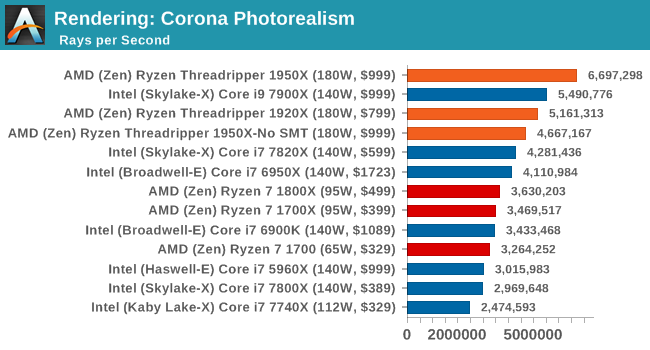
Corona loves threads.
Blender 2.78: link
For a render that has been around for what seems like ages, Blender is still a highly popular tool. We managed to wrap up a standard workload into the February 5 nightly build of Blender and measure the time it takes to render the first frame of the scene. Being one of the bigger open source tools out there, it means both AMD and Intel work actively to help improve the codebase, for better or for worse on their own/each other's microarchitecture.
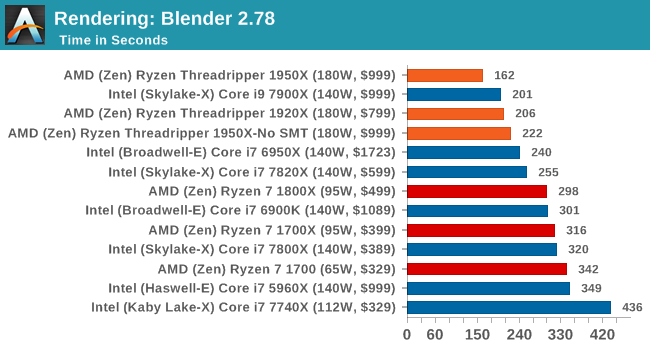
Blender loves threads and memory bandwidth.
LuxMark v3.1: Link
As a synthetic, LuxMark might come across as somewhat arbitrary as a renderer, given that it's mainly used to test GPUs, but it does offer both an OpenCL and a standard C++ mode. In this instance, aside from seeing the comparison in each coding mode for cores and IPC, we also get to see the difference in performance moving from a C++ based code-stack to an OpenCL one with a CPU as the main host.
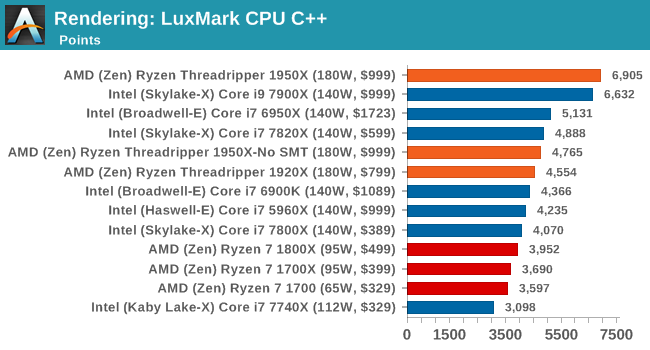
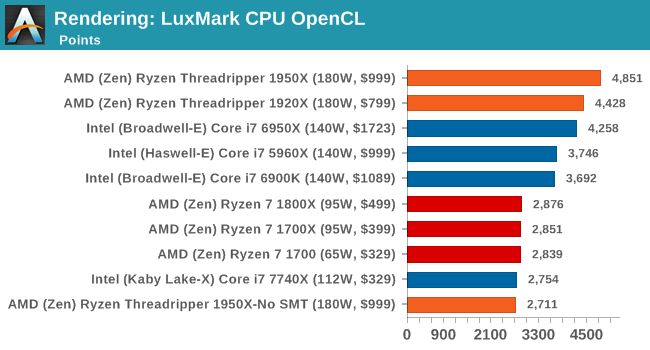
Like Blender, LuxMark is all about the thread count. Ray tracing is very nearly a textbook case for easy multi-threaded scaling. Though it's interesting just how close the 10-core Core i9-7900X gets in the CPU (C++) test despite a significant core count disadvantage, likely due to a combination of higher IPC and clockspeeds.
POV-Ray 3.7.1b4: link
Another regular benchmark in most suites, POV-Ray is another ray-tracer but has been around for many years. It just so happens that during the run up to AMD's Ryzen launch, the code base started to get active again with developers making changes to the code and pushing out updates. Our version and benchmarking started just before that was happening, but given time we will see where the POV-Ray code ends up and adjust in due course.
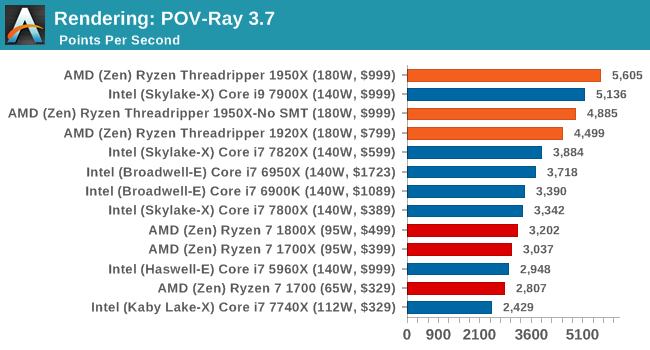
Similar to LuxMark, POV-Ray also wins on account of threads.
Cinebench R15: link
The latest version of CineBench has also become one of those 'used everywhere' benchmarks, particularly as an indicator of single thread performance. High IPC and high frequency gives performance in ST, whereas having good scaling and many cores is where the MT test wins out.
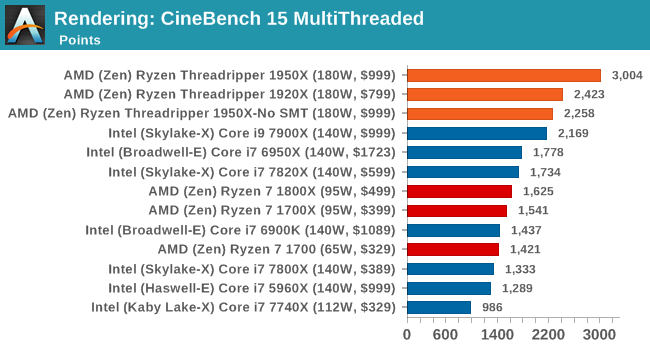
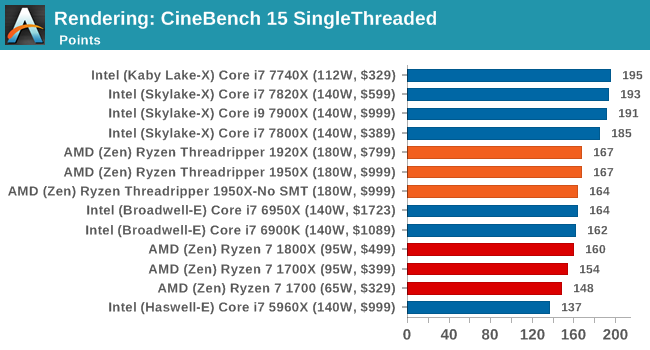
Intel recently announced that its new 18-core chip scores 3200 on Cinebench R15. That would be an extra 6.7% performance over the Threadripper 1950X for 2x the cost.










347 Comments
View All Comments
sorten - Friday, August 11, 2017 - link
Swole? Threadripped?Rottie - Friday, August 11, 2017 - link
AMD Ryzen CPU is not fast enough. Apple is not ready for AMD Ryzen CPU, sorry AMD. I love AMD but I hated Intel even though I have a Skylake based MacBook Pro. :(Deshi! - Friday, August 11, 2017 - link
One small correction, Ryzen has 24 PCIE lanes, not 16. it has 16 for graphics only, but saying only 16 may make people (like me) wonder if you can't run an NVME at x4 and still have the graphics card at 16x, which you totally can do.Deshi! - Friday, August 11, 2017 - link
This is under Feeding the beast section btw, where you said "Whereas Ryzen 7 only had 16 PCIe lanes, competing in part against CPUs from Intel that had 28/44 PCIe lanes,"fanofanand - Tuesday, August 15, 2017 - link
He already answered this question/statement to someone else. there are 20 lanes from the CPU, 16 of which are available for graphics. I don't think his way of viewing it seems accurate, but he has stated that this is how PCIe lanes have been counted "for decades"WaltC - Friday, August 11, 2017 - link
Nice review, btw! Yes, going all the way back to Athlon and the triumph of DDR-Sdram over Rdram, and the triumph of AMD's x86-64 over Itanium (Itanium having been Intel's only "answer" for 64-bit desktop computing post the A64 launch--other than to have actually paid for and *run* an Intel ad campaign stating "You don't need 64-bits on the desktop", believe it or not), and going all the way back to Intel's initial Core 2 designs, the products that *actually licensed x86-64 from AMD* (so that Intel could compete in the 64-bit desktop space it claimed didn't exist), it's really remarkable how much AMD has done to enervate and energize the x86 computing marketplace globally. Interestingly enough it's been AMD, not Intel, that has charted the course for desktop computing globally--and it goes all the way back to the original AMD Athlon. The original Pentium designs--I owned 90MHz and 100MHz Pentiums before I moved to AMD in 1999--were the high-point of an architecture that Intel would *cancel* shortly thereafter simply because it could not compete with the Athlon and its spin-off architectures like the A64. That which is called "Pentium" today is not...;) Intel simply has continued to use the brand. All I can say is: TGF AMD...;) I've tried to imagine where Intel would have taken the desktop computing market had consumers allowed the company to lead them around by the nose, and I can't...;) If not for AMD *right now* and all the activity the company is bringing to the PC space once again, there would not be much of a PC market globally going on. But now that we have some *action* again and Intel is breaking its legs trying to keep up, the PC market is poised to break out of the doldrums! I guess Intel had decided to simply nap for a few decades--"Wake me when some other company does something we'll have to compete with!" Ugh.zeroidea - Friday, August 11, 2017 - link
Hi Ian,On the Civ 6 benchmark page, all results after the GTX 1080 are mislabeled as GTA 6.
Ahmad Rady - Friday, August 11, 2017 - link
Can you try to test this CPU using windows server?This is a MCM CPU looks like 4 CPUs attached to each other.
I think windows 10 Pro can't get the most of this CPU unless we have windows 10 Pro for WS
Pekish79 - Friday, August 11, 2017 - link
Vray has a Rendering Benchmark too maybe you could use bothPekish79 - Friday, August 11, 2017 - link
I went to check both page of Vray and Corona BenchmarkCorona match more or less the graphic and Vray has the following
AMD 1950 : 00:46-00:48 sec
I9 7900: 00:54-00:56 sec
I7 6950: 01:00-01:10 sec
I5 5960: 01:23-01:33 sec